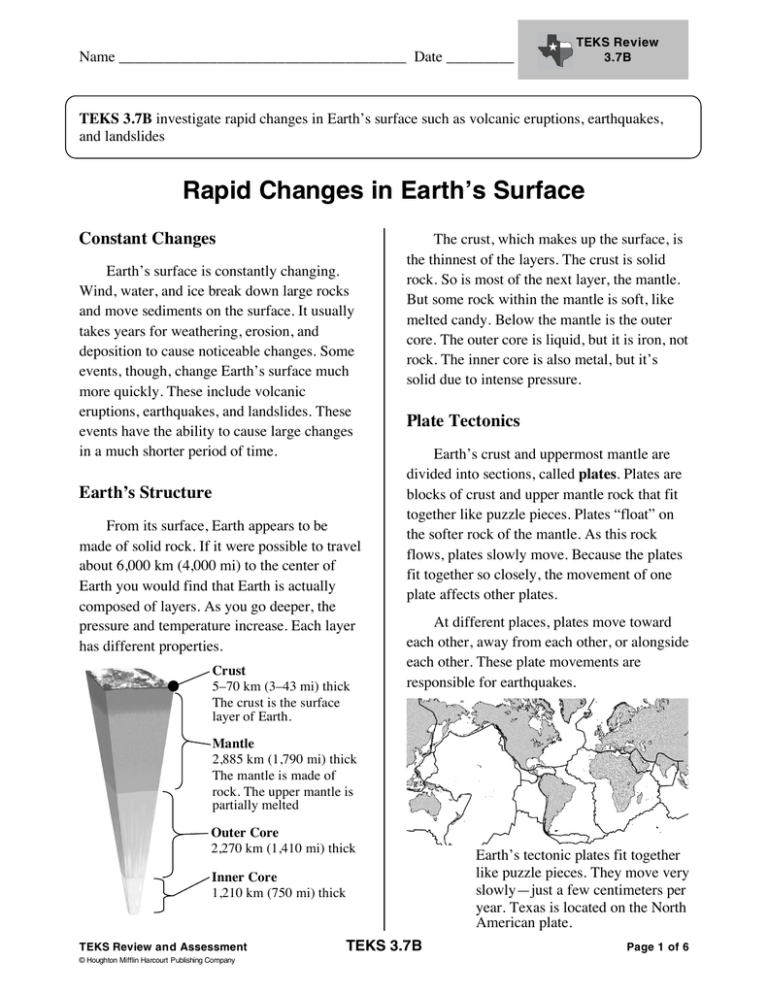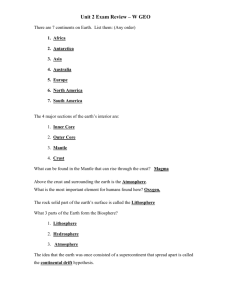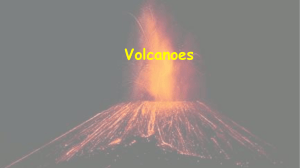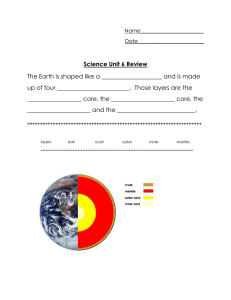Rapid Changes in Earth`s Surface
advertisement

Name ______________________________________ Date _________ TEKS Review 3.7B TEKS 3.7B investigate rapid changes in Earth’s surface such as volcanic eruptions, earthquakes, and landslides Rapid Changes in Earth’s Surface Constant Changes Earth’s surface is constantly changing. Wind, water, and ice break down large rocks and move sediments on the surface. It usually takes years for weathering, erosion, and deposition to cause noticeable changes. Some events, though, change Earth’s surface much more quickly. These include volcanic eruptions, earthquakes, and landslides. These events have the ability to cause large changes in a much shorter period of time. Earth’s Structure From its surface, Earth appears to be made of solid rock. If it were possible to travel about 6,000 km (4,000 mi) to the center of Earth you would find that Earth is actually composed of layers. As you go deeper, the pressure and temperature increase. Each layer has different properties. Crust 5–70 km (3–43 mi) thick The crust is the surface layer of Earth. The crust, which makes up the surface, is the thinnest of the layers. The crust is solid rock. So is most of the next layer, the mantle. But some rock within the mantle is soft, like melted candy. Below the mantle is the outer core. The outer core is liquid, but it is iron, not rock. The inner core is also metal, but it’s solid due to intense pressure. Plate Tectonics Earth’s crust and uppermost mantle are divided into sections, called plates. Plates are blocks of crust and upper mantle rock that fit together like puzzle pieces. Plates “float” on the softer rock of the mantle. As this rock flows, plates slowly move. Because the plates fit together so closely, the movement of one plate affects other plates. At different places, plates move toward each other, away from each other, or alongside each other. These plate movements are responsible for earthquakes. Mantle 2,885 km (1,790 mi) thick The mantle is made of rock. The upper mantle is partially melted Outer Core 2,270 km (1,410 mi) thick Inner Core 1,210 km (750 mi) thick TEKS Review and Assessment © Houghton Mifflin Harcourt Publishing Company TEKS 3.7B Earth’s tectonic plates fit together like puzzle pieces. They move very slowly—just a few centimeters per year. Texas is located on the North American plate. Page 1 of 6 Name ______________________________________ Date _________ TEKS Review 3.7B Earthquakes Suppose you press your hands together as hard as you can. If one hand slips, energy is released suddenly and your hands move past each other. The same thing happens in Earth’s crust. The movement of plates causes pressure to build up where two plates are colliding or sliding past one another. These areas are called faults, which are breaks in Earth’s crust. When the pressure builds to a certain point, the plates move, energy is released, and the ground shakes. An earthquake is a shaking of the ground caused by a sudden release of energy in Earth’s crust. Most earthquakes are too small to be felt, but they can be measured using a seismometer. Strong earthquakes can cause a great deal of damage to buildings and roads. Earthquakes cause rapid changes to Earth’s surface. They may cause the ground to rupture, or break, along the fault. A major earthquake can move land several meters. An earthquake in the ocean floor can transfer energy to the water above and cause a tsunami. A tsunami is a fast-moving wave that can cause a large volume of water to flow onshore and damage coastal regions. Often, a tsunami washes away everything in its path. Volcanoes The melted rock in Earth’s mantle is called magma. In some places, magma reaches the surface. A volcano is a vent, or opening, in the surface of Earth through which magma and hot gases erupt. Magma is called lava when it reaches the surface. In addition to lava, materials ejected from the vent could include cinder, pumice, and ash. TEKS Review and Assessment © Houghton Mifflin Harcourt Publishing Company Volcanoes can change Earth’s surface in many ways. Flowing lava and ejections of cinder, pumice, and ash build up to create volcanic mountains. A powerful eruption can destroy trees many kilometers away as hot gases and ash flow from the volcano. Ash can be sent high into Earth’s atmosphere. The ash from a volcanic eruption forms very fertile soils over time. Volcanic activity lays down thick, dense layers of rock. The Hawaiian Islands were formed by volcanic activity, which continues today. Similarly, melted rock cools and forms new land where two plates are pulling apart. Most volcanoes go through long periods during which they are dormant, or inactive. During this time, the crater at the volcano’s peak may fill with water and form a lake. Sinkholes If you dig deep enough into the soil, you will eventually find rock. Sometimes, underground water wears away rock and forms a cave underground. If the cave collapses, the ground above falls into it. This forms a sinkhole on Earth’s surface. TEKS 3.7B Page 2 of 6 Name ______________________________________ Date _________ Landslides If you have ever taken a trip through a mountainous area, you may have seen road signs warning of falling rocks. Weathering causes rocks to break free, and gravity pulls them tumbling down the mountainside. Sometimes, the same thing happens with a large area of rock or soil at once. A landslide is the fast movement of soil and rocks down a slope. Landslides can be very dangerous. TEKS Review 3.7B Landslides occur in the ocean, along the coast, and on shore. Many factors determine how stable a slope is. Some landslides occur naturally. They are set off by heavy rains, floods, earthquakes, or volcanoes. Excessive human development and construction grading can also cause landslides. Hands-On Activity Materials Make a Landslide There is a maximum slope that can exist for any given soil. We will investigate this slope with different types of materials. Procedure: 1. Cover the lab table or desk with paper to help with cleanup. Slowly pour the dry sand through the funnel onto the flat surface so that it makes a pile. Take notes about what happens to the sides of the pile as you pour the sand. • 500 mL each of fine sand, mud, gravel, potting soil, and sugar, in separate containers • funnel • protractor • paper to cover the desk 2. Hold a protractor upright in the pile of sand so that you can measure the angle of the side of the pile. Read and record the angle in degrees. What happens if you add more sand to the pile? How does the measurement change? 3. After you have cleaned up all of the sand, repeat steps 1 and 2 with the mud, gravel, potting soil, and sugar. 4. Compare the angles for all the materials. Discussion Questions: 1. What happened to the sides of the pile as you poured the sand? 2. How does the angle change for each material? TEKS Review and Assessment © Houghton Mifflin Harcourt Publishing Company TEKS 3.7B Page 3 of 6 TEKS Review 3.7B Name ______________________________________ Date _________ Volcanoes and Landslides Read each statement and write T for true or F for false. _____ Magma that reaches the surface and flows from a volcano is called lava. _____ The thick layer of rock beneath Earth’s crust is called the mantle. _____ A crater is the name of the hole at the top of the volcano’s vent. It may contain a lake. _____ Dormant is the word used to describe a volcano that is erupting. _____ Gases, molten rock, lava, and rocks are thrown out of an erupting volcano. _____ Earth’s plates move several meters each year. _____ Landslides are always very large. _____ Landslides frequently occur during periods of intense rainfall or rapid snow melt. _____ Landslides in the United States occur only on the coastlines. _____ Earthquakes can cause the crust to crack. Volcano Diagram Label the diagram by using the words in the word bank. b. Word Bank gases, ashes, and cinders lava vent magma c. a. d. TEKS Review and Assessment © Houghton Mifflin Harcourt Publishing Company TEKS 3.7B Page 4 of 6 Name ______________________________________ Date _________ TEKS Review 3.7B TEKS Assessment 3.7B Fill in the letter of the best choice. Volcanoes and earthquakes are most likely to occur— What occurs when the pressure that has built between two plates is suddenly released? in the center of a plate at plate boundaries new crust forms instantly along the coast of a continent volcanoes occur slowly anywhere earthquakes happen suddenly mountains form quickly What causes the movement of Earth’s plates? Use the drawing below to answer questions 6–7. landslides A ocean currents shaking that occurs in Earth’s inner core movement of melted rock in the mantle What is a fault? a place on Earth where earthquakes cannot occur a fracture on Earth’s surface where movement has occurred the place where the most damage occurs during earthquakes another name for an earthquake Which location is most likely to be damaged by a tsunami? What do the arrows represent? the motion of plates the eruption of a volcano the cause of a tsunami the formation of a crater What is the area labeled A called? joint fault a coastline canyon a volcanic crater plate a rain-soaked slope a snow-covered mountainside TEKS Review and Assessment © Houghton Mifflin Harcourt Publishing Company TEKS 3.7B Page 5 of 6 Name ______________________________________ Date _________ TEKS Review 3.7B Hands-On Activity (p. 3) 1. At first, the pile will grow higher. Once it reaches a certain height, particles that land near the top of the pile will be pulled down the sides of the pile by gravity. The particles will not form a structure that is steeper than a certain angle. 2. Answers will vary, but should be based on the measurements taken with the protractor. Student Response Activity (p. 4) 1. T 6. F 11. a. lava 2. T 7. F b. gases, ashes, and cinder 3. T 8. T c. vent 4. F 9. F d. magma 5. T 10. T TEKS Assessment (p. 5) 1. B 2. D 3. B 4. A 5. C 6. A 7. B TEKS Review and Assessment © Houghton Mifflin Harcourt Publishing Company TEKS 3.7B Page 6 of 6




